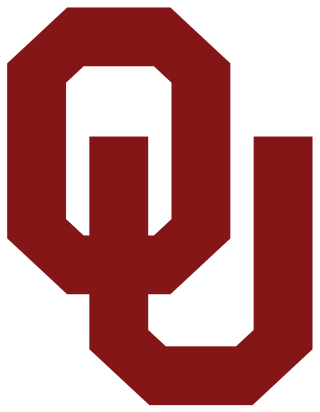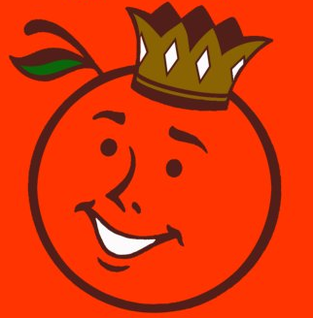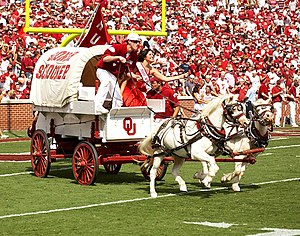
Boomer and Sooner are two matching white ponies who pull the Sooner Schooner, a Conestoga wagon across the field when the University of Oklahoma football team scores. The Sooner Schooner is the true mascot of the team, bringing to mind the pioneers who settled Indian Territory during the 1889 Land Run and were the original "Sooners". The Sooner Schooner represents the University of Oklahoma as a mascot for the university and its sports teams, the Oklahoma Sooners.

The RUF/NEKS are the nation's oldest all-male spirit squad of its kind for the University of Oklahoma and the 2nd oldest in the world.

The Washington Huskies football team represents the University of Washington in college football. Washington competed in the NCAA Division I Football Bowl Subdivision (FBS) as a member of the Big Ten Conference, after having been a charter member of the Pac-12 Conference until the end of the 2023-2024 season. Husky Stadium, located on campus in Seattle, has been the Huskies' home field since 1920.

The Oklahoma Sooners football team represents the University of Oklahoma (OU) in college football at the NCAA Division I Football Bowl Subdivision level in the Southeastern Conference (SEC). The program began in 1895 and is one of the most successful in history, having won 949 games and possessing a .725 winning percentage, both sixth all-time. Oklahoma has appeared in the AP poll 905 times, including 101 No. 1 rankings, both third all-time. The program claims seven national championships, 50 conference championships, 167 first-team All-Americans, and seven Heisman Trophy winners. The school has had 29 former players and coaches inducted into the College Football Hall of Fame and holds the record for the longest winning streak in Division I history with 47 straight victories. Oklahoma is also the only program with which four coaches have won more than 100 games each.
The 2005 Rose Bowl Game was the 91st edition of the college football bowl game, held on January 1, 2005 at the self-named stadium in Pasadena, California. The Texas Longhorns, second-place finishers in the Big 12 Conference's South Division, defeated the Michigan Wolverines, co-champions of the Big Ten Conference, 38-37. Texas quarterback Vince Young and Michigan linebacker LaMarr Woodley were named the Rose Bowl Players of the Game, the first time that the Rose Bowl separately recognized an offensive and defensive player of the game.

The 1985 Oklahoma Sooners football team represented the University of Oklahoma in the 1985 NCAA Division I-A football season. This year was Barry Switzer's 13th season as head coach. The Sooners ended this season with 11 wins and a sole loss coming to the Miami Hurricanes in Norman, in a game in which the Sooners lost starting quarterback Troy Aikman for the season. The Sooners were forced to place their trust in freshman quarterback Jamelle Holieway and a physical defense featuring three All-Americans, who led them to a Big 8 Conference title and a national championship. This was Oklahoma's sixth national championship and 34th conference championship in school history.
The 2001 Sugar Bowl was a 2000–01 BCS game played on January 2, 2001. This 67th edition to the Sugar Bowl featured the Florida Gators, and the Miami Hurricanes, in an in-state rivalry game. Miami came into the game ranked 3rd in the BCS, 2nd in both the Coaches and AP Poll, at 10–1, whereas Florida came into the game ranked 7th in the BCS at 10–2. Sponsored by Nokia, the game was officially known as the Nokia Sugar Bowl.
The 1979 Orange Bowl was the 45th edition of the college football bowl game, played at the Orange Bowl in Miami, Florida, on Monday, January 1. Part of the 1978–79 bowl game season, it matched the fourth-ranked Oklahoma Sooners and #6 Nebraska Cornhuskers, both of the Big Eight Conference.
The 1977 Orange Bowl was the 43rd edition of the college football bowl game, played at the Orange Bowl in Miami, Florida, on Saturday, January 1. Part of the 1976–77 bowl game season, it matched the eleventh-ranked Ohio State Buckeyes of the Big Ten Conference and the #12 Colorado Buffaloes of the Big Eight Conference. Behind early, favored Ohio State won 27–10.
The 1954 Orange Bowl was a postseason American college football bowl game between the first-ranked Maryland Terrapins and the fourth-ranked Oklahoma Sooners. It was the twentieth edition of the Orange Bowl and took place at the Orange Bowl stadium in Miami, Florida on January 1, 1954.
The 1972 Rose Bowl was the 58th edition of the college football bowl game, played at the Rose Bowl in Pasadena, California, on Saturday, January 1. The Stanford Indians of the Pacific-8 Conference upset the undefeated and fourth-ranked Michigan Wolverines of the Big Ten Conference by a point, 13–12, repeating as Rose Bowl champions. The Player of the Game was Stanford quarterback Don Bunce.

The 1988 Orange Bowl was the 54th edition of the college football bowl game, played at the Orange Bowl in Miami, Florida, on Friday, January 1. Part of the 1987–88 bowl game season, it matched undefeated teams: the independent and second-ranked Miami Hurricanes and the #1 Oklahoma Sooners of the Big Eight Conference.
The 1985 Orange Bowl was the 51st edition of the college football bowl game, played at the Orange Bowl in Miami, Florida, on Tuesday, January 1. Part of the 1984–85 bowl game season, it matched the fourth-ranked Washington Huskies of the Pacific-10 Conference and the #2 Oklahoma Sooners of the Big Eight Conference. Underdog Washington rallied to win 28–17.
The 1976 Fiesta Bowl was the sixth edition of the college football bowl game, played at Sun Devil Stadium in Tempe, Arizona on Saturday, December 25. Part of the 1976–77 bowl game season, it matched the eighth-ranked Oklahoma Sooners of the Big Eight Conference and the unranked Wyoming Cowboys of the Western Athletic Conference (WAC). Heavily favored Oklahoma won in a rout, 41–7.
The 1972 Sugar Bowl (January) was the 38th edition of the college football bowl game, played at Tulane Stadium in New Orleans, Louisiana, on Saturday, January 1. It featured the third-ranked Oklahoma Sooners of the Big Eight Conference and the #5 Auburn Tigers of the Southeastern Conference (SEC). The favored Sooners won 40–22.
The 1986 Orange Bowl was the 52nd edition of the college football bowl game, played at the Orange Bowl in Miami, Florida, on Wednesday, January 1. Part of the 1985–86 bowl game season, it matched the independent and top-ranked Penn State Nittany Lions and the #3 Oklahoma Sooners of the Big Eight Conference. Favored Oklahoma trailed early but won 25–10.
The 1981 Orange Bowl was the 47th edition of the college football bowl game, played at the Orange Bowl in Miami, Florida, on Thursday, January 1. Part of the 1980–81 bowl game season, it matched the fourth-ranked Oklahoma Sooners of the Big Eight Conference and the independent #2 Florida State Seminoles.
The 1980 Orange Bowl was the 46th edition of the college football bowl game, played at the Orange Bowl in Miami, Florida, on Tuesday, January 1. Part of the 1979–80 bowl game season, it matched the fourth-ranked independent Florida State Seminoles and the #5 Oklahoma Sooners of the Big Eight Conference. Favored Oklahoma overcame an early deficit and won 24–7.
The 1969 Orange Bowl was the 35th edition of the college football bowl game, played at the Orange Bowl in Miami, Florida, on Wednesday, January 1. The final game of the 1968–69 bowl game season, it matched the independent third-ranked Penn State Nittany Lions and the #6 Kansas Jayhawks of the Big Eight Conference. Favored Penn State rallied to win with a late touchdown and two-point conversion, 15–14.
The 1968 Orange Bowl was the 34th edition of the college football bowl game, played at the Orange Bowl in Miami, Florida, on Monday, January 1. The third-ranked Oklahoma Sooners of the Big Eight Conference defeated the Tennessee Volunteers of the Southeastern Conference (SEC), 26–24.






